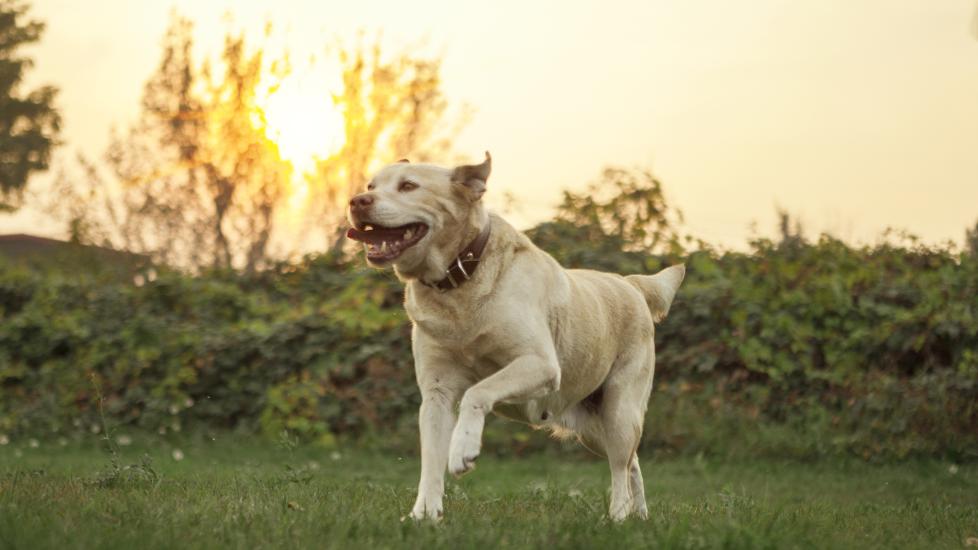Exercise-Induced Collapse in Dogs
What Is Exercise-Induced Collapse in Dogs?
Exercise-induced collapse (EIC) is a genetic condition in affected dogs that causes progressive weakness and collapse after strenuous exercise. It results from a gene mutation that is responsible for maintaining muscle tone during periods of exercise.
EIC begins with weakness in the hind limbs that progresses to the front limbs with sustained exercise. This leads to collapse and inability to move the limbs until the dog recovers.
Affected dogs typically are okay when performing light-to-moderate exercise, but when intensity increases, problems arise. As little as five minutes of intense exercise can trigger an episode.
EIC is relatively rare in dogs overall but is most common in Labrador Retrievers. Male and female dogs are affected equally. The onset of symptoms usually begins by the time the dog is 3 years old. It often goes undiagnosed until the first episode, because these dogs appear normal—both medically and physically—prior to the onset of strenuous exercise.
Although most dogs recover on their own within about 30 minutes, some dogs do experience severe reactions that can be fatal. This is especially common if exercise is continued even after the dog begins showing signs of weakness.
If you notice your dog becoming weak or collapsing following exercise, it should be treated as a medical emergency. Your dog should be brought to the veterinarian to determine the underlying cause.
If your dog is diagnosed with EIC, your veterinarian can advise you on how to handle future episodes based upon your dog’s unique needs and overall health.
Symptoms of Exercise-Induced Collapse in Dogs
Exercise-induced collapse can cause a variety of symptoms in affected dogs, which include the following:
-
Wide stance
-
Muscle weakness, especially in the hind legs
-
Dragging hind legs
-
Lack of coordination, stumbling
-
Sudden collapse during exercise
-
Inability to move after exercise
-
Increased temperature (fever)
-
Seizures (rare)
It’s important to note that symptoms will get progressively worse if exercise is not stopped at the first sign of weakness. Watch your dog closely and discontinue exercise immediately if an abnormal walk is seen.
Causes of Exercise-Induced Collapse in Dogs
EIC is caused by an inherited gene mutation. This means it can be passed down through generations. Strenuous exercise causes EIC in dogs with this mutation. Examples of exercise that may result in EIC include the following:
-
Playing ball
-
Running
-
Agility competitions
-
Intense training
-
Playing with other dogs
Some dogs are predisposed to this condition compared with others. In addition to Labrador Retrievers, Cocker Spaniels, Corgis, German Wirehaired Pointers, and Old English Sheepdogs are also commonly diagnosed with EIC.
How Veterinarians Diagnose Exercise-Induced Collapse in Dogs
To diagnose this condition, veterinarians first perform full physical and neurological exams and collect a thorough history from the dog’s pet parent.
A sample of blood will be collected to check for signs of inflammation, infection, or underlying illnesses. Sometimes, X-rays are needed to rule out underlying skeletal issues that may require sedation if your dog is nervous or unable to remain still.
If these tests are all normal, a DNA test can check for the genetic mutation causing EIC.
This test involves swabbing the inside of your dog’s cheek and sending it to a special laboratory for testing. If your dog has the genetic mutation and has had symptoms consistent with exercise-induced collapse, this condition is definitively diagnosed.
Treatment of Exercise-Induced Collapse in Dogs
There are no medical treatments available for EIC.
Instead, treatment consists of limiting exercise and reducing triggers that may lead to collapse. Pet parents should keep their dog on a leash when outside to prevent them from running around.
They will also need plenty of enrichment, such as puzzle toys or a stuffed Kong® that will provide them something to do while keeping them safe.
EIC doesn't shorten your dog’s lifespan, but pet parents will need to limit their dog’s activity to only mild exercise, such as short walks, to prevent symptoms.
Dogs typically experience fewer episodes as they age.
Recovery and Management of Exercise-Induced Collapse in Dogs
Most dogs recover and return to normal within 30 minutes after an episode of EIC; however, for some dogs, EIC can be fatal.
If you notice early signs of EIC, such as weakness in the hind legs, stop your dog from exercising immediately.
Provide them with a calm, quiet environment to recover, and avoid any additional stressors.
Because exercise can increase a dog’s body temperature, it's a good idea to use a fan to help cool your dog down. If your dog is alert and oriented, offer them some cool water.
Call your veterinarian for additional guidance.
Prevention of Exercise-Induced Collapse in Dogs
Because EIC is caused by a genetic mutation, the only way to prevent this condition is to not breed carriers of the mutated gene. In dogs who have the condition, limiting triggers and avoiding strenuous exercising can prevent symptoms.
Exercise-Induced Collapse in Dogs FAQS
What is the life expectancy of a dog with exercise-induced collapse?
Dogs with EIC generally live normal, healthy lives. However, pet parents should ensure they are avoiding trigger activities that result in EIC, to improve their quality of life.
Is exercise-induced collapse dangerous?
EIC can be dangerous, particularly if exercise is not stopped at the first sign of symptoms. Progression of symptoms can lead to death in some dogs.
Featured Image: Nastasic/E+ via Getty Images

